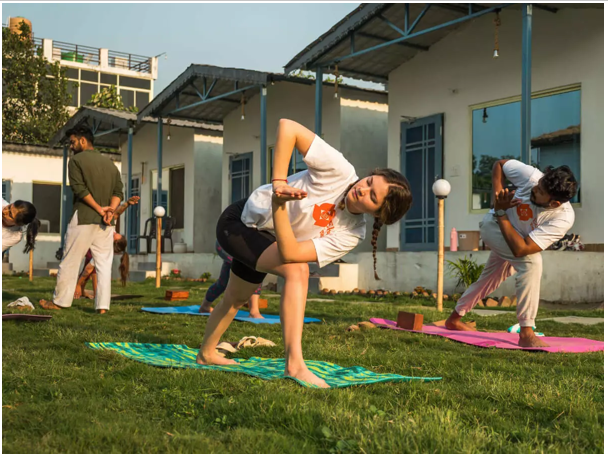Days of peaceful meditation, spiritual enlightenment, and mentorship from masters in the cradle of yoga came to mind when I first decided to enroll in a Yoga Teacher Training course in India. Little did I realize how deeply transformative, challenging, and enriching this adventure would be—not just physically but also emotionally and psychologically.
Every day of my training was like entering a world that balanced traditional practices with strong self-discovery.
This blog will follow a regular day in my life during my 200-hour Yoga Teacher Training in India. I’ll tell my own stories, the everyday schedule, the feelings, the lessons, and how this trip evolved to be more than just a certification—it became a path to a new way of life.
Setting the Scene: Immersed in India’s Yogic Heartland
Arriving in India felt like stepping into a sacred rhythm that had existed long before me. The smells of incense, the distant sounds of temple bells, and the warm smiles of locals set the tone for what was to become an inner and outer journey. I had always associated yoga with slow, intentional living and soulful self-exploration, but it wasn’t until I landed at my ashram in the foothills of the Himalayas that those ideals truly took form.
The campus was surrounded by nature—lush trees, distant mountains, and pathways where barefoot walking felt instinctive. It wasn’t luxurious, but it radiated simplicity and purpose. The moment I arrived, I felt a profound shift, as though I had entered a different plane of awareness.
The energy was calm, yet charged. Everyone was there for a reason—to learn, to heal, to grow. Some came seeking a deeper purpose, others to expand their yoga practice. I quickly realized that while we all had different backgrounds, we shared a collective openness. This wasn’t just a training ground for future yoga teachers—it was a sanctuary for transformation.
In those first few days, as I settled into my room, adjusted to the time difference, and absorbed the stillness, I found myself slowly detaching from the pace of my past life. The digital noise faded. Silence became a teacher. Nature became a companion. And as my feet began to feel rooted in Indian soil, I understood that yoga here was more than a curriculum—it was a lived experience. One that would meet me at every sunrise, every breath, and every challenge that lay ahead.
Before the Dawn: Waking Up to the Call of Yoga
Long before the sun fully rose, my day started early, often around 5:00 a.m. The pre-dawn stillness is something magical, quiet that prompts inner introspection. My mornings were accompanied by the soft chime of bells from the neighboring temple and far off chanting drifting in the breeze.
Getting out of bed wasn’t always easy. The body will rebel following the demanding asanas and pranayama exercises of the day before. Still, the temptation to open the day with yoga was overpowering.
Meditation came first, always. Eyes closed, I sat cross-legged on the hardwood floor of our open-air shala (yoga studio) and concentrated on my breath to ground myself. Meditation set my mind and got me ready to meet the physical and mental needs ahead.
Morning Asana Practice: Flowing with the Sun
The group would meet for the morning asana session by 6:00 AM. The air was clear and fragrant, laced with blooming jasmine and frangipani trees around the training facility. Typically, a seasoned yogi with decades of experience, our instructor would lead us through routines that helped to clear the mind and rouse the body.
Though dynamic, the practice was conscious. Beginning gently with warm-ups, we would proceed to sun salutations (Surya Namaskar,) synchronized breath, and movement. The speed would progressively rise to include standing poses, balance postures, and deep stretches.
The Indian morning sun’s warmth, the chirping birds, and the group energy helped to make the asana practice feel sacred. Notwithstanding the physical effort, there was an almost pervasive quietness.
Breakfast & Community Connection
The aroma of fresh chai and home vegetarian cuisine drew us to the dining area after practice. Typically on the menu were steamed idlis, spicy chutneys, fresh fruit, and perhaps parathas with yoghurt, all healthy mainstays.
Eating together produced a sense of community. We talked about what the day could bring, looked on the morning exercise, and swapped stories. Dining with other students from throughout the globe made the experience more complex. United by a common love of yoga, we were a melting pot of civilizations.
Theory Classes: Diving into Yoga Philosophy
The late morning was set aside for theory sessions. Our course went far into the old writings, like the Bhagavad Gita and Patanjali’s Yoga Sutras, unlike many Western yoga curricula that concentrate mostly on physical practice.
These courses were illuminating. Studying the eight limbs of yoga, the tenets of ahimsa (non-violence) and satya (truthfulness), as well as the deeper spiritual aims of yoga changed my perspective from exercise to a comprehensive way of life.
The teacher promoted energetic chats and inquiries. Though sometimes dense or abstract, the content started to strike a deep resonance slowly. I started thinking about how these lessons fit contemporary life and my struggles.
Lunch & Midday Rest
Lunch was often rather basic but nutritious and was usually ready around noon. Highlights of the trip are lentil, rice, fresh veggies, and occasionally dosa or chapati—Indian vegetarian cuisine. Cooked with love and suited to meet our body’s detoxification and energy requirements, the meal was prepared.
We noted a brief rest period following lunch. This day was vital; many of us simply rested in hammocks or took naps. The rigorous physical and mental training required us to respect this downtime.
Afternoon Workshops & Practical Training
The afternoons mixed specialized workshops with hands-on teaching approaches. We practiced sequencing lessons and learnt how to clearly and safely teach pupils. We also looked at anatomy, muscles, joints, and how the body moves in several postures.
These classes were interactive and sometimes difficult. Instructing a posture while keeping alignment, handling a class, and offering modifications tested my self-assurance. To watch my own weekly improvement was both humbling yet motivating.
On some days, we would hold pranayama (breath control techniques), chanting mantas, or Ayurveda—the ancient Indian medical approach. These inclusions gave the training an Indian cultural depth and holistically oriented character.
Evening Meditation and Reflection
We met once more as the day came to a close for an evening meditation or mantra event. The scent of incense and the gentle glow of oil lights contributed to a serene setting.
To digest the events of the day, release tension, and connect inside, this was a holy opportunity. Frequently, the instructor would conduct directed meditations or contemplations on the lessons of the day. We occasionally sang bhajans—devotional songs that raised our spirits.
Here, the sense of community grew stronger. Even though tired, nobody rushed out. We stayed and exchanged ideas, helping one another on this transforming path.
Dinner & Unwinding
Though equally delicious, dinner consisted of soups, steamed vegetables, and occasionally kitchari—a soft cleansing dish made of mung beans and rice—and was lighter than lunchtime. Once more, we dined together, usually laughing, and discussed our findings.
Most evenings were leisure. Some students read old holy texts, some logged, and others went for walks in the nearby community. Often gazing at how different the nighttime sky appeared from home, I sat under the stars.
Challenges Along the Way
India’s yoga teacher training is not always an easy road. Between the demanding schedule and the odd cuisine, climate, and culture, I was challenged.
Occasionally, homesickness came in. Physical pain and mental exhaustion were always with me. I had to develop compassion for my mind’s restlessness and patience with my body’s limitations.
Self-doubt times came when I wondered if I could absorb all and instruct others. But these obstacles also evolved into resilience and surrendering instruction.
Transformation: More Than Just a Certificate
Weeks of intense training revealed this encounter to be far more than merely studying anatomy or practicing postures. It concerned developing connection, presence, and consciousness—to myself, to others, and an eternal tradition.
Initially, rigidly organized and difficult, my daily life finally evolved into a balanced rhythm. I discovered how to listen to my body, embrace agony, and open my heart.
This journey was profoundly transforming in terms of the friendships developed, the knowledge acquired, and the spiritual insights gained.
Conclusion
One of the most satisfying events of my life was completing my Yoga Teacher Training in India. Every day brought us closer to more self-understanding and a deeper respect for yoga as a way of life.
Should you be thinking about a similar path? I advise you to accept the difficulties, surrender to the process, and let the experience transform you in unforeseen ways.
Yoga is a continuous path of development, healing, and relationship, not only a workout on the mat. That voyage comes alive in every breath, every posture, and every minute in the heart of India, where it all started.


